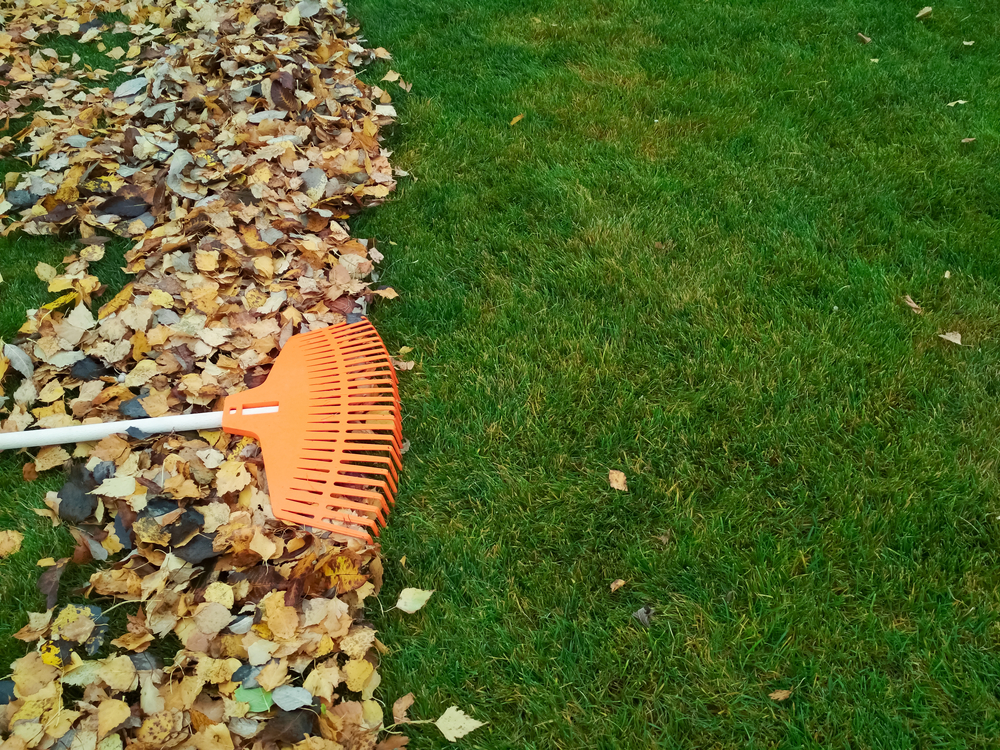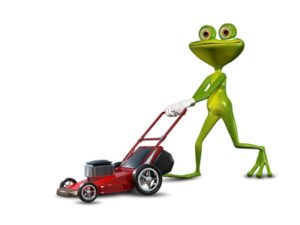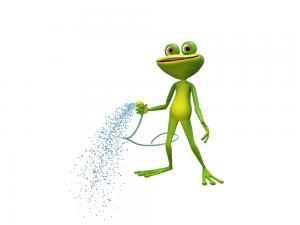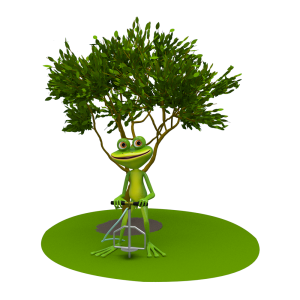
One of the best ways to ensure a healthy lawn in the spring is to take care of it properly in the fall.
Below are some tips on what you should do this fall to prepare your lawn for winter:
1. Rake Leaves & Remove
We all likely know that we should rake our leaves in the fall and remove them from the lawn, but do you know why this is so important?
“Your lawn relies on a constant supply of sunlight, water and air. Raking leaves off of the lawn allows the grass blades to breathe and absorb moisture for thirsty roots. If you do not rake the leaves from the grass, they slowly form a wet barrier. Pathogens can easily breed on the damp leaves, which causes widespread damage to the turf below.” (Source: SF Gate)
Raking also helps to ensure that your thatch layer doesn’t grow too thick (more than 1″). Thatch is the layer of decaying foliage found between the soil surface and growing glass blades.
If you’re not a fan of raking, then use your lawnmower to collect leaves and use them for compost or use your lawnmower to mulch the leaves and leave them on your lawn. Mulching leaves and leaving them on your lawn benefits the lawn and soil by providing nutrients and organic matter.
2. Keep Mowing but Not Too Short
 Your grass will keep growing up to the first hard frost. Continue to mow your lawn, as needed throughout fall, keeping it at 2-1/2″ to 3″ in height.
Your grass will keep growing up to the first hard frost. Continue to mow your lawn, as needed throughout fall, keeping it at 2-1/2″ to 3″ in height.
As the season draws to a close and your grass stops growing, it is time for the last cut before winter. Cut your lawn to 2″ to 2-1/2″, but no shorter.
Cutting your grass too short is one of the biggest lawn care mistakes you can make!
Cutting your grass too short damages the crown, creating a weakness in your lawn, increasing threats from weeds and diseases. Mowing your lawn a bit shorter for winter helps to ward off diseases like snow mold while not being so short that it is stressed out by the cold weather. Also, mowing your grass shorter for winter allows more sunlight to reach the crown of the grass and there will be less leaf to turn brown during the winter.
3. Aerate Regularly
 By aerating in the fall, oxygen, water and fertilizer have better chances of reaching the roots of your grass.
By aerating in the fall, oxygen, water and fertilizer have better chances of reaching the roots of your grass.
Regular aerating also helps avoid soil compaction and excessive thatch by inserting holes in the thatch and pulling up plugs of soil. It is also a good idea to fertilize after you aerate as the holes will allow the fertilizer to go right to the roots, where it will be most effective.
Earth Smart Property Solutions offers spring and fall Core Aeration services.
Not sure if your lawn needs aerating? Check out our blog, Signs Your Lawn May Need Aerating.
4. Fertilize
 Fall fertilization is likely one of the most important fertilizer applications of the year.
Fall fertilization is likely one of the most important fertilizer applications of the year.
In the fall, the grass blades slow in growth as the weather cools and the hours of daylight shorten. During this time, while the top growth slows, the grass plant is still busy socking away nutrients to the roots so it will have plenty of energy to come back out of dormancy in the spring. The nutrients in fertilizer applied during the fall are absorbed into your grass and applied directly to the root system. Strengthening your lawn’s root system in the fall months will provide your lawn with reserves to draw from in the spring.
A strong root system can make or break your lawn during stressful conditions.
If applying fertilizer, it is important that you don’t apply it too early or too late in the season. If you fertilize too early, your grass may send up new growth that will freeze in the cold. If you fertilize too late, the grass roots won’t be able to absorb the nutrients being provided.
Earth Smart Property Solutions has been providing fertilizer services for over 26 years in Alberta for residential, commercial and industrial clients. Contact our Calgary or Red Deer office if you would like help with fertilizing your lawn.
5. Fill in Bald Spots
Sparse lawns are more prone to take over by weeds. A thick healthy lawn leaves less room for weeds to pop up.
Fall is the best time of year to fill in bald spots on your lawn as the ground is generally still warm, the sun is not as hot during the day, nights are cool and moisture is more plentiful. Cool season grasses are best seeded in the fall.
We offer Overseeding services in our Red Deer location if you are not comfortable taking on this task yourself.
6. Weed Control
During the fall weeds go into an energy-absorbing mode. They’re drinking in everything that comes their way … including weed killers. Apply a herbicide in the fall to help prevent the return of weeds in the spring.
We offer a variety of weed control services to help eliminate weeds in your lawn and vegetation control services to help get rid of unwanted vegetation in your back lane, sidewalks and more.
7. Water
As we head into winter, your lawn needs water to keep the grass roots well hydrated and healthy.
As the weather gets cooler, if it’s dry, make sure to keep watering your lawn approximately an inch of water per week.
8. Fertilize Your Trees
 If your trees, shrubs, and hedges are showing signs of stress, are young or very mature, be sure to apply deep root fertilizer.
If your trees, shrubs, and hedges are showing signs of stress, are young or very mature, be sure to apply deep root fertilizer.
Not sure if your trees are stressed? Check out our blog, Signs Your Trees May Need Fertilizer.
We offer Deep Root Tree and Shrub Fertilizing services to keep your trees and shrubs healthy year round.
Before winter arrives and your grass goes dormant, be sure to follow these tips in order to have healthy grass come spring.
Don’t have time to take care of your property or would like more information? Please contact us and we will be happy to help! We offer a Fall Clean Up (includes mowing plus raking and removal of leaves), Core Aeration, Deep Root Tree and Shrub Fertilization and more.
Sources:
Earth Smart Solutions, “Lax Lawn Care Now = Lacklustre Lawn Later: 6 Fall Lawn Care Tips”
This Old House, “7 Lawn Care Musts for Your Fall Yard”
The Spruce, “Biggest Lawn Care Mistake“
Green Oasis, “Fall Lawn Care Tips for a Thick Healthy Lawn This Spring”
Source: SF Gate, Home Guides, Purpose of Raking Leaves

One Comment